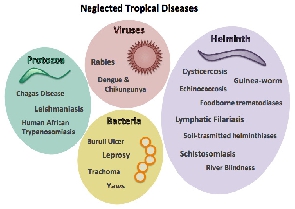 Neglected Tropical Diseases are the cause substantial illness for more than 1.7 billion people
Neglected Tropical Diseases are the cause substantial illness for more than 1.7 billion people
Neglected Tropical Diseases (NTDs) are a group of diseases numbering about 20 that cause substantial illness for more than 1.7 billion people living in the poorest and most marginalized communities worldwide. NTDs impair physical and cognitive development, contribute to mother and child morbidity and death, and limit productivity. (CDC - Neglected Tropical Diseases-, 2021).
These diseases cause not only blindness or disabilities but also deformity to people, taking away their health, chances of staying in school and work. In the worst-case scenario, sufferers may lose their lives. A few examples of the NTDs include Dracunculiasis (Guinea Worm Disease), Lymphatic Filariasis (elephantiasis), Onchocerciasis (river blindness), Schistosomiasis (bilharziasis), Soil-transmitted Helminths (STH) (i.e., Ascaris, Hookworm, and Whipworm), and Trachoma (Granular conjunctivitis).
According to research, Trachoma is the world’s leading infectious cause of blindness. NTDs tend to flourish in low-resourced regions of the world, where water quality, sanitation, and access to health care are inadequate.
Ever wondered why they are referred to as "neglected,"? your guess isn’t far from being valid. It is merely because they predominantly afflict the world's poor and for time immemorial have not received as much attention as other diseases. For instance, they are not regarded as a priority market for pharmaceutical manufacturers or health risk for developed countries. Again, majority of the people infected by the so-called NTDs are impoverished and marginalized populations, with low visibility and little political voice. These populations suffer in silence with none to advocate for them.
Their socio-economic impact leaves much to be desired. NTDs like any other long-term diseases have a catastrophic effect on the individual, family, community, and the nation as a whole. They result in a double-barreled of an NTDs-Poverty and Poverty-NTDs vicious cycle. This simply means NTDs can lead to poverty and vice versa.
The poverty-stricken farmer who makes a living mainly via farming may be deprived of this livelihood after contracting an NTD. Family members spend productive hours caring for the bedridden sick to the neglect of their activities of daily living (ADL). And this can hurl the family into abject poverty. Additionally, the costs of treatment, mainly long-term ones, can inflict further economic difficulties in populations already struggling to live with less than US$ 1 a day.
The greatest danger of NTDs is their effect on the achievement of the much-anticipated Universal Health Coverage (UHC). For UHC to be successfully achieved, coverage for and prevention of NTDs is inevitable. The attainment of UHC hinges colossally on the mitigation of NTDs. Better still, NTDs are key drivers and determinants for the accomplishment of UHC. Again, it is incongruous to talk of arriving at the Sustainable Development Goals (SDGs) by the year 2030 without plans of tackling NTDs. A cursory glance at the 17 SDGs depicts the inclusion of factors such as health and well-being, poverty, personal and environmental hygiene which are the fuel for the spread and thrive of NTDs.
Nonetheless, NTDs are largely preventable. Majority of them can be prevented even without any vaccines. Common personal and environmental hygiene practices such as; use of clean water, hygienic food handling, and proper waste management and disposal can prevent waterborne and water-washed diseases such as trachoma, guinea-worm disease, schistosomiasis, and soil-transmitted helminthiasis.
Mass spraying with insecticide in vector breeding areas also comes in handy in eliminating Vector-borne NTDs, especially those that are spread by worms, flies, and mosquitoes. For instance, eliminating areas of standing water, where mosquitoes like to breed, will decrease the peril of mosquito-borne diseases, or sleeping under an insecticide-treated bed net will decline the possibility of diseases spread by flies.
Educating the population at-risk and creating their awareness about the menace is also an important step of NTDs prevention. Travelers to places where insect-borne NTDs are widespread should wear protective clothing, use bug repellant, and sleep under a treated bed net.
Importantly, social interventions targeting the poor and marginalized individuals could advertently break the Poverty-NTDs and the NTDs-Poverty chain. The provision of adequate potable drinking water for domestic consumption for rural and remote area dwellers is yet another tread in the right direction.